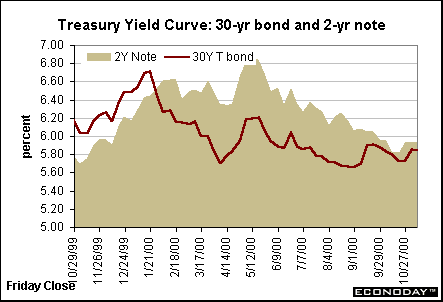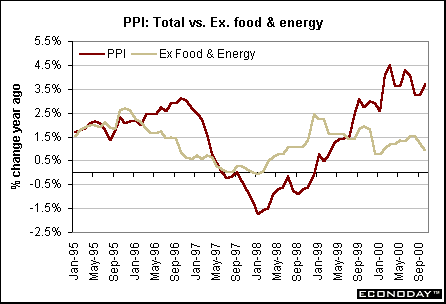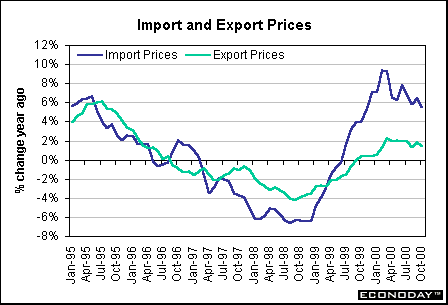|
 |
 |
Inflation tame; election wild
Econoday Simply Economics 11/9/00
By Evelina M. Tainer, Chief Economist |
Election uncertainty leads to market unraveling
Market players have various opinions about Democrats and Republicans. They might attribute one with favorable implications for stock prices and the other with negative implications. But worst of all for market players, is uncertainty. Stock prices mostly tumbled after election results didn't yield a winner in the presidential derby on Tuesday. Recounts are set not only for Florida, but also demanded for Wisconsin and New Mexico.

Treasury securities drift in a tight range
Bond prices seemed to fluctuate less radically than equity prices this week. While it doesn't really matter who wins the presidential election from the standpoint of the 2001 economy, the bond market does have a preference. It seems that bond investors believe a Bush win would create greater inflationary pressures because of his social security proposal. Bond market players seem to think that the budget surplus would shrink and a greater number of Treasury securities would be brought to market than under a Gore victory. This is definitely ironic when one considers that the Republican faction has always been considered anti-inflationary in the past, while Democrats have been considered big spenders in a big government. Gore's social security views and federal debt pay down seem to be more in tune with the bond market.

Markets
at a Glance
|
| Treasury Securities |
12/31/99 |
2000
High |
2000
Low |
3-Nov |
9-Nov |
Week %
Change |
| 30-year Bond |
6.48% |
6.75% |
5.66% |
5.86% |
5.85% |
-0.01% |
| 10-year Note |
6.43% |
6.77% |
5.68% |
5.82% |
5.81% |
-0.01% |
| 5-year Note |
6.34% |
6.81% |
5.90% |
5.85% |
5.76% |
-0.09% |
| 2-year Note |
6.24% |
6.90% |
6.07% |
5.93% |
5.93% |
0.00% |
| |
|
|
|
|
|
|
| Fed Funds Rate Target |
5.50% |
6.50% |
5.50% |
6.50% |
6.50% |
0.00% |
| |
|
|
|
|
|
|
| Stock
Prices |
|
|
|
|
|
|
| DJIA |
11497 |
11723 |
9811 |
10818 |
10834 |
0.2% |
| S&P 500 |
1469 |
1524 |
1348 |
1427 |
1400 |
-1.9% |
| NASDAQ Composite |
4069 |
5049 |
3164 |
3452 |
3200 |
-7.3% |
| Russell 2000 |
505 |
606 |
457 |
508 |
495 |
-2.4% |
| Wilshire 5000 |
13813 |
14751 |
12475 |
13383 |
13029 |
-2.6% |
| |
|
|
|
|
|
|
| Exchange
Rates |
|
|
|
|
|
|
| $/Euro |
1.0008 |
0.8269 |
1.0336 |
0.8669 |
0.8664 |
-0.1% |
| Yen/$ |
102.40 |
111.35 |
101.45 |
107.40 |
107.39 |
0.0% |
| |
|
|
|
|
|
|
| Commodity
Prices |
|
|
|
|
|
|
| Crude Oil ($/barrel) |
$25.60 |
$37.20 |
$21.20 |
$32.60 |
$33.96 |
4.2% |
| Gold ($/ounce) |
$289.60 |
$326.00 |
$273.90 |
$266.30 |
$267.00 |
0.3% |
| |
|
|
|
|
|
|
Inflation report tame after energy
The producer price index rose 0.4 percent in October after posting a whopping 0.9 percent gain in the previous month. Energy prices were the main culprit with a 1.4 percent rise in October after a 3.7 percent hike in September. In October, food prices jumped too - up 0.8 percent - which was twice as fast as the previous month. As a result, the year-over-year gain in the PPI was back up to 3.6 percent after a brief downward trend in the past couple of months.

Excluding the volatile food and energy components, producer prices look much better. In October, the core PPI edged down 0.1 percent - and is only up 1 percent from a year earlier. Notice that the chart does show a nice downward trend in core PPI prices over the past few months. This report showed that passenger car prices fell 1.8 percent while light truck prices dropped 1.2 percent. This may not be altogether reflective of underlying trends. According to the Bureau of Labor Statistics, the drop in motor vehicle prices came from a quality adjustment with the introduction of new model year vehicles. In the past, quality adjustments have tended to boost car and truck prices at this time of year. Perhaps the seasonal adjustment factor exacerbated this effect. It is likely that some of this could be overturned in the next few months. Even if it isn't, don't expect to see such price declines in these particular components.
In contrast, drug prices jumped 1.6 percent during the month and civilian aircraft prices gained 1.4 percent. Also, women's apparel prices jumped 0.7 percent after declining in the past few months.
Economists and market players also like to look at the PPI at earlier stages of processing to see if there are inflationary pressures in the pipeline. Apart from a burst in energy prices at the crude materials level, core price indices were subdued in the crude and intermediate price measures. This bodes well for future finished goods prices.

Earlier in the week, the Labor Department reported that import prices fell 0.5 percent in October due to a 3.2 percent drop in petroleum import prices. Non-oil import prices were unchanged for the month. Consequently, the yearly change in import prices fell back to 5.5 percent. Export prices are remaining relatively stable. The export price index dipped 0.1 percent in October and now stands 1.4 percent above year ago levels.
The bottom-line on inflation? The producer price index suggests that inflation remains pretty much under control. Energy prices continue to be a problem, but the core components of the producer price index are subdued. Granted, not all categories are posting declines, but not all are posting increases either. This suggests that the core component of the CPI reported next week could also show some good news.
THE BOTTOM LINE
It was not a very important week from the standpoint of economic news. Market activity was focused on the results of the presidential and congressional elections. The uncertainty is creating some skittishness in the financial markets - causing bond yields to inch higher and stock prices to fall. After the election results are finally resolved, we may see some stability in these markets. In any case, next week's economic calendar is filled with market moving indicators (retail sales, industrial production, CPI, and housing starts). This may get financial market participants focused on the economy once again.
Looking Ahead: Week of November 13 to 17
Market News International compiles a market consensus that surveys 15 - 20 economists each week.
Tuesday
The consensus calls for a modest drop in retail sales in October after a 0.9 percent gain in September. This reflects the drop in motor vehicle sales for the month. Excluding autos, economists are predicting retail sales to rise 0.3 percent, less than half of the 0.7 percent gain posted in the previous month.
Wednesday
The FOMC meets. Market players don't expect the Fed to shift their inflation risk bias to neutral.
Business inventories are predicted to rise 0.3 percent in September. This would be significantly smaller than the 0.7 percent gain posted in August. A slowdown in production has generally kept inventories well aligned with sales in recent months.
The market consensus is calling for a 0.1 percent gain in the index of industrial production for October. This is similar to the meager 0.2 percent hike recorded last month. With virtually no change in production, it means that the capacity utilization rate will edge down to 82 percent from a level of 82.2 percent in September.
Thursday
Market participants are expecting new jobless claims to decrease 29,000 in the week ended November 11 from last week's 344,000 level, which were boosted by strike activity.
Economists are looking for a 0.2 percent rise in the consumer price index in October. Excluding food and energy prices, the CPI should also increase 0.2 percent for the month, a bit less than last month's 0.3 percent gain.
The Philadelphia Fed's business outlook survey is expected to increase to -1.0 in November from a level of -3.8 in October. Any level below zero signifies a contracting manufacturing sector.
Friday
Market players expect new housing starts to rise 1.3 percent in October to a 1.55 million-unit rate. This would be the second straight monthly gain, but from the standpoint of actual statistical significance, starts are essentially unchanged. The slight upward tilt could stem from the lower level of mortgage rates in recent weeks. Economists are predicting housing permits to remain roughly unchanged from September's level of 1.52 million.
|